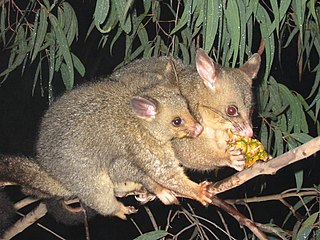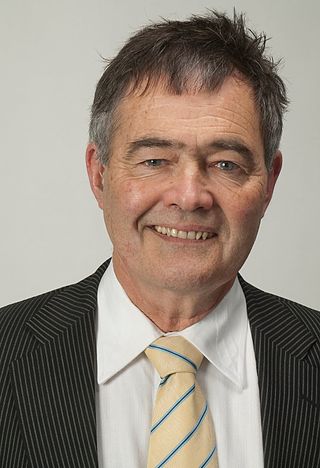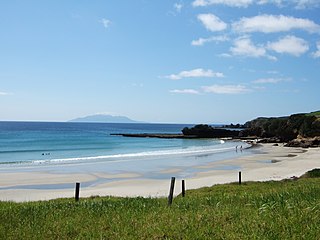Related Research Articles

Alexandra is a town in the Central Otago district of the South Island of New Zealand. It is on the banks of the Clutha River, on State Highway 8, 188 kilometres (117 mi) by road from Dunedin and 33 kilometres (21 mi) south of Cromwell. The nearest towns to Alexandra via state highway 8 are Clyde seven kilometres to the northwest and Roxburgh forty kilometres to the south. State highway 85 also connects Alexandra to Omakau, Lauder, Oturehua, Ranfurly and on to Palmerston on the East Otago coast.

The New Zealand falcon is New Zealand's only falcon. Other common names for the bird are bush hawk and sparrow hawk. It is frequently mistaken for the larger and more common swamp harrier. It is the country's most threatened bird of prey, with only around 3000–5000 breeding pairs remaining.

Cromwell is a town in Central Otago region of the South Island of New Zealand. Cromwell is located on the shores of Lake Dunstan where the Kawarau river joins Lake Dunstan. Cromwell was established during the Otago gold rush and is now more known as one of the sub regions of the Central Otago wine region. In 2018, the town of Cromwell was home to a population of 5610 people.

The South Island takahē is a flightless swamphen indigenous to New Zealand and the largest living member of the rail family. It is often known by the abbreviated name takahē, which it shares with the recently extinct North Island takahē. The two takahē species are also known as notornis.

Rabbiting is the sport of hunting rabbits. It often involves using ferrets or dogs to track or chase the prey. There are various methods used in capturing the rabbit, including trapping and shooting. Depending on where the hunting occurs, there may be licenses required and other rules in regards to methods being used.

Secretary Island is an island in southwestern New Zealand, lying entirely within Fiordland National Park. Roughly triangular in shape, it lies between Doubtful Sound / Patea in the south and Te Awa-o-Tū / Thompson Sound in the north, with its west coast facing the Tasman Sea. To the east of the island, Pendulo Reach connects Te Awa-o-Tū / Thompson Sound with Doubtful Sound / Patea. Steeply sloped, the entirely bush-clad island rises to a chain of several peaks higher than 1000 metres. The highest of these is the 1,196-metre (3,924 ft) Mount Grono, the highest peak in the main New Zealand chain not located in the North or South Island. The island also contains three lakes. The largest, Secretary Lake, over 600 metres (2,000 ft) long, is located beneath Mount Grono at an altitude of 550 metres (1,800 ft).
Southland Boys' High School (SBHS) is an all-boys school in Invercargill, New Zealand, and has been the only one in the city since Marist Brothers was merged with St Catherines to form Verdon College in 1982.
Paerau is a small settlement in inland Central Otago in New Zealand's South Island. It is located in the Strath Taieri, the upper valley of the Taieri River, at the foot of the Rock and Pillar Range. "Paerau" is a Māori-language name meaning "one hundred ridges".

Dunstan High School is a state secondary school located in Alexandra, in the Central Otago district in the South Island of New Zealand.

Orokonui Ecosanctuary, called Te Korowai o Mihiwaka in Māori, is an ecological island wildlife reserve developed by the Otago Natural History Trust in the Orokonui Valley between Waitati and Pūrākaunui, New Zealand, 20 kilometres (12 mi) to the north of central Dunedin.

Pūkaha National Wildlife Centre is a captive breeding facility and visitor centre located in a protected forest area on State Highway 2 in New Zealand's Tararua district. It was formerly called Mount Bruce National Wildlife Centre, then Pūkaha / Mount Bruce National Wildlife Centre.

1080, the brand name given to the synthetic form of sodium fluoroacetate, is used in New Zealand in efforts to control populations of possums, rats, stoat and rabbits, which are invasive species in the New Zealand environment. Although the Parliamentary Commissioner for the Environment deemed the use of 1080 in New Zealand "effective and safe" in a 2011 re-evaluation and the substance is widely considered to be the most effective tool currently available for controlling possums over large areas, it remains a contentious issue, with the majority of the debate occurring between conservationists and livestock farmers on one side and hunters and animal-rights activists on the other.

The Clutha Mata-Au River Parkway Group, New Zealand, was registered as an Incorporared Society in December 2003 and registered with Charities Servics in 2008 The Group was set up in response to land development issues along the Clutha River / Mata-Au corridor, much of which has high scenic and recreational values. The project aims to establish a regional river parkway, including a river trail, along the entire 338 km river corridor from Lake Wānaka to the Pacific Ocean.

Acclimatisation societies to naturalise all kinds of new species —as long as they had no harmful effect— were established in New Zealand by European colonists from the 1860s, with the first likely having been established in Auckland around 1861.

The stoat was introduced into New Zealand to control introduced rabbits and hares, but is now a major threat to the native bird population. The natural range of the stoat is limited to parts of the Northern Hemisphere. Immediately before human settlement, New Zealand did not have any land-based mammals apart from bats, but Polynesian and European settlers introduced a wide variety of animals. Rarely, in Southland, the fur of stoats has been reported to turn white, being the fur known as ermine, which adorns royal robes.

David Charles Cull was the mayor of the city of Dunedin in New Zealand. He became the 57th Mayor of Dunedin in October 2010 and was re-elected in both the 2013 mayoralty race and 2016 mayoral election. Before politics, he was a presenter for Television New Zealand and an author.
John Davidson McCraw was a New Zealand pedologist, academic, and local historian, particularly of the Central Otago area. The McCraw Glacier in Antarctica is named for him.
The Mayor of Central Otago officiates over the Central Otago District of New Zealand which is administered by the Central Otago District Council. The first Mayor of Central Otago was W.S. McIntosh who was elected in 1989, when following the local government reforms of that year, the Central Otago District Council was formed in the place of the previous county and borough councils of Central Otago.

Tāwharanui Regional Park is a regional park on the Tāwharanui Peninsula in the Auckland Region of New Zealand's North Island. It is located in Rodney, east of Warkworth and north of Auckland.

Galloway is a rural locality in the Central Otago District of Otago in New Zealand. It is about 6.5 km northeast of Alexandra, on the eastern bank of the Manuherikia River, opposite Springvale.
References
- ↑ Chamberlain, Rhys (14 April 2017). "Central Otago Great Easter Bunny Hunt is massacre, activists say". Stuff.
- 1 2 Kuprienko, Dasha (18 April 2017). "Alexandra hunter takes second place for the tenth time at Easter Bunny Hunt". Stuff.
- ↑ "Rabbits". Otago Regional Council. 23 February 2021.
- 1 2 3 4 5 6 "Bunny Hunt". New Zealand Geographic. May–June 2016.
- ↑ "More Central Otago farms leave Easter Bunny Hunt competition this year". Stuff.
- ↑ Manins, Rosie (19 April 2010). "Record broken in Easter bunny hunt". Otago Daily Times.
- ↑ "Hunters cull Easter bunnies". New Zealand Herald. Otago Daily Times.
- ↑ van Kempen, Lynda (27 April 2012). "Bunny hunt a win for the rabbits". Otago Daily Times.
- ↑ Marquet, Sarah (1 April 2013). "Hunt leaves 18,695 dead, one injured". Otago Daily Times.
- ↑ van Kempen, Lynda (21 April 2014). "Lower count at Bunny Hunt". Otago Daily Times.
- ↑ van Kempen, Lynda (6 April 2015). "2015 Great Easter Bunny Hunt". Otago Daily Times.
- ↑ McKenzie-McLean, Jo (27 March 2016). "Southlanders dominate in Central Otago's Great Easter Bunny Hunt". Stuff.
- ↑ Jones, Pam (4 April 2019). "Central Otago Great Easter Bunny Hunt cancelled due to fire risk". New Zealand Herald. Otago Daily Times.
- ↑ Hunt, Elle (4 April 2021). "New Zealand town where Easter is all about wiping out bunnies". The Guardian.
- ↑ McClure, Tess (7 April 2023). "Unable to shoot rabbits this Easter, New Zealand mulls deadly virus to fight 'plague'". The Guardian. ISSN 0261-3077 . Retrieved 8 September 2023.